The Four Seasons
You’ve heard me describe the 24-hours of sunlight here, but do you really understand why? Let’s dive into the science.
It all has to do with why we have the four seasons here on earth.
It is a popular misconception to think that it’s warmer in the summertime because the sun it closer to the earth and colder in the wintertime because the sun is farther from the earth. This isn’t the case. The distance from the earth to the sun does fluctuate a tiny amount – 91.4 million miles at its minimum and 94.5million miles at it’s maximum - but this is not nearly enough to cause the changes in the seasons.
Instead, the four seasons come from the tilt of the earth. Earth is tilted at 23.5 degrees from its axis.
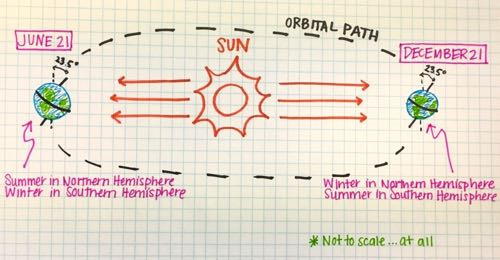 Disclaimer: I do not claim to be a good artist. This diagram may help you picture how the tilt of the earth creates the four seasons.
Disclaimer: I do not claim to be a good artist. This diagram may help you picture how the tilt of the earth creates the four seasons.
When it’s summertime in the northern hemisphere, the tilt of the earth is aligned such that the sun’s rays are shinning directly on the northern hemisphere. The opposite is true with the southern hemisphere, which is experiencing its winter. This occurs on the Summer Solstice, June 21.
And when it’s summertime in the southern hemisphere, the tilt of the earth is aligned such that the sun’s rays are shinning more directly on the southern hemisphere. Again, the opposite is true with the northern hemisphere, which is experiencing its winter. This occurs on the Winter Solstice, December 21.
Due to some really interesting geometry (I’ll leave it to you to work out the details), the sun will never rise more than 23.5degrees in the sky at the South Pole. It reaches its highest point on, you guessed it, the Winter Solstice – December 21!
South Pole Seasons
The South Pole takes the seasons to the extremes. Just as you back in the U.S. experience more hours of sunlight in the summer, here at the South Pole we experience 24-hours of sunlight. Then, in the wintertime, when you back in the U.S. experience fewer hours of daylight, here at the South Pole they experience 24-hours of darkness. Imagine that!
Talking to some people who spend the winter here (the “winter-overs” as we call them), they describe the transitions to be a few days of the sun setting (late March) and few days of sunrise (late September).
Summertime Means Warmer Temperatures…Relatively
Just because it’s summertime here at the Pole doesn’t mean I’m sunbathing in a bikini.
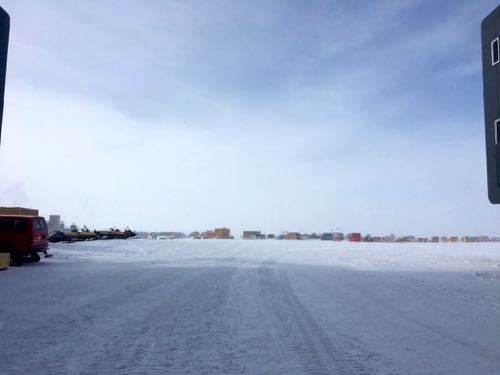 Just a not-so-nice summer day at the South Pole. Winds at 17 knots and a wind chill of -40.
Just a not-so-nice summer day at the South Pole. Winds at 17 knots and a wind chill of -40.
The average summer temperature at the South Pole is -14F. That really is warm when compared to the winter average of -72F! Burr!
As they say here, "It's a harsh continent."
You Try!
I’d like to figure out the angle of the sun in the sky right now in mid-January. I know it’s got to be less than 23.5 degrees that it hit on the Winter Solstice on December 21, but can we get more accurate?
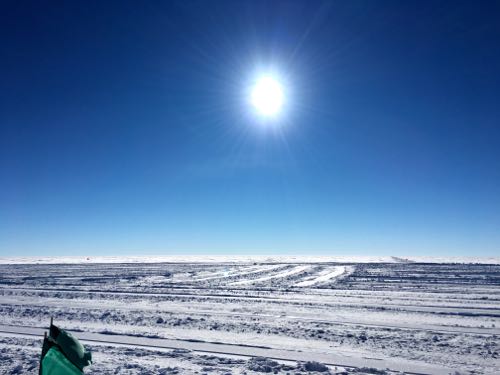 The sun sits low in the sky at the South Pole…but how low?
The sun sits low in the sky at the South Pole…but how low?
I took a few measurements of myself and my shadow and a snowman and his shadow. From this, you should be able to help me figure out the angle of the sun!
Ms. Miller's Shadow Data
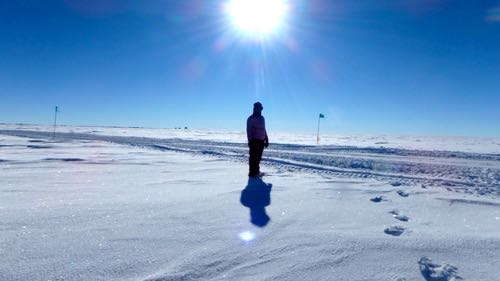 With the sun so low in the sky, my shadow is pretty long.
With the sun so low in the sky, my shadow is pretty long.
Height of Ms. Miller: 1.56m
Length of Ms. Miller's Shadow: 4.05m
Ralph the Snowman's Shadow Data
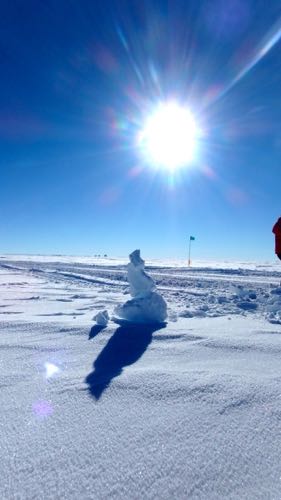 Meet my snowman. I named him Ralph. Ralph also has a long shadow.
Meet my snowman. I named him Ralph. Ralph also has a long shadow.
Ralph's Height: 0.79m
Length of Ralph's Shadow: 1.90m
Solve
Goal: Find the angle of the sun in the sky!
Hint: Draw a picture and look for a way to use some trig.
Extension: Average your angles calculated from the snowman and me together. Then find the uncertainty by calculating half the range of the angles from the snowman and me.
Solution
After you try the calculations, take a look at my solution below.
 The solution to the angle of the sun give Ms. Miller & Ralph the Snowman's height and shadow data.
The solution to the angle of the sun give Ms. Miller & Ralph the Snowman's height and shadow data.
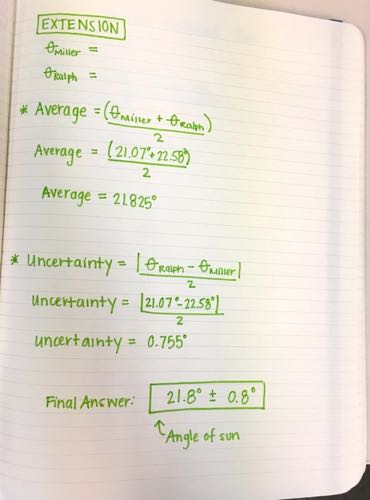 The solution to the extension, combining Ms. Miller & Ralph the Snowman's solutions.
The solution to the extension, combining Ms. Miller & Ralph the Snowman's solutions.

Add new comment